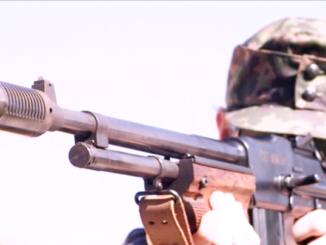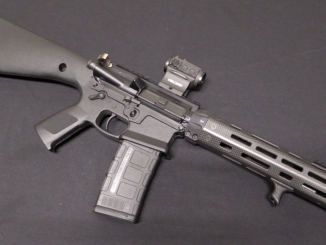Patented in 1855 by James Butterfield, this revolver is a 5-shot, .41 caliber percussion revolver with a brass frame and 7.5 inch barrel. Aside from its somewhat unorthodox grip configuration, what makes it interesting and unusual is that it was designed to automatically feed pellet primers, obviating the need to cap the cylinder manually after loading.
Butterfield got a contract to make 2300 of his revolvers for the Ira Harris Guards (later renamed the 5th and 6th New York Volunteer Infantry), but the contract was ended prematurely and only 640 guns were produced. Details aren’t available, but one would suspect that the money simply ran out. Thanks in part to the truncated production, these are quite rare secondary military pistols today.




I wonder what was supposed to keep the powder from shaking/dribbling out of the open nipples, as ell as keeping rain out?
Rocket paper could be a possibility but that easily catches fire. Sadly that was also rejected by the Army as another waste of money, to say nothing of rewriting the drill book to account for the idea of a paper cartridge you don’t have to bite open (and one that doesn’t like smoking hot ashes left in the gun).
The inside of the percussion nipple has a much smaller hole that would prevent the powder from falling out. I would worry about moisture with this opening. When I was hunting with a flint lock rifle which has a touch hole directly through the barrel I never had a problem except with the 4f priming powder that set in the pan. After a couple of hours I would brush it out with a feather and replace it.
“its somewhat unorthodox grip configuration”
Shape of this revolver instantly reminded me about Collier Flintlock Revolver.
Both are reminiscent of single-shot pistol, cf. for example Pistolet Modèle 1822 T: http://www.pistol3d.com/percussie_m1822t/m1822t.html
It closely resembles that of quite a few earlier “pepperbox” double-action-only pistols. And also the Pettengill army revolver, a double-action-only, concealed-hammer .44 percussion arm;
http://armscollectors.com/mgs/army_revolvers_part_1.htm
The Pettengill was intended as a rapid-fire, close quarters battle pistol and made no pretense of being anything else.
cheers
eon
For users accustomed to longer-than-tall weapons like single-shot percussion pistols or cylinder-ahead-trigger-guard-revolver, revolvers in now “classic” layout (cylinder above trigger) must like contraption. This might be one reason why Colt Patersen percussion revolver lack trigger guard – thus visually it is less tall.
If you mean that such users were a bit put off by unfamiliar handling, then yes, the modern revolver layout did look like some over-engineered contraption. More parts meant more complications for the user in maintenance.
“More parts meant more complications for the user in maintenance.”
This is another issue, similarly to early revolver, some early automatic pistols (late 19th century/early 20th century) were made to be similar to revolvers, most obvious in that case were exposed barrels, but others features too, for example magazine outside grip, which allowed free choice of grip shape.
“contract was ended prematurely and only 640 guns were produced. Details aren’t available, but one would suspect that the money simply ran out.”
I was unable to find Butterfield patent, but some time earlier Maynard patented in 1845 similar solution – tape-primer, also used in revolvers, see 1st photo from bottom: http://www.littlegun.info/arme%20americaine/artisan%20m/a%20maynard%20gb.htm
Question is does Maynard and Butterfield intersect? If so was there patent infringement case?
Maynard tape-primer .28 caliber revolver seems to be bit bigger success that Butterfield, as according to linked site less than 3000 made.
“.41 caliber percussion revolver”
BTW: Which calibers were standard in 1850s for percussion revolvers?
I am aware that users often cast bullets themselves unlike modern era, but still some standardization would give benefits. So far I though there were 3 standard sizes:
.31 caliber – for pocket revolvers
.36 caliber – for navy revolvers
.44 caliber – for army revolvers
Does other standard calibers exist or they were oddities?
Found some data regarding caliber which I mentioned here:
http://www.wideopenspaces.com/practical-uses-cap-and-ball-revolver/
These seems to be, in term of bullet mass and muzzle velocity, roughly equivalent to .25 Auto, .32 S&W Long and .40 S&W respectively.
Still it does not answer what about other calibers?
.31, .36, and .44 were the U.S. standards. There were also some .28 calibers early on, but they were rare.
European standards were generally 7mm for pocket revolvers (including “fist guns”- short-barreled pepperboxes), 9mm for civilian defensive revolvers, and up to 11mm and even 12mm for military sidearms. Interestingly, the Lefaucheux pinfire model 1858 was listed as a 12mm pinfire, but it was just the cartridge case that was 12mm in diameter, at the rear; the bore and bullet were closer to 9.5mm.
.41 caliber began with the various types of percussion “derringers”, with Henry Deringer himself making the earliest ones; he judged that .36 wasn’t powerful enough, and that .44 made the pistol too big and resulted in too much recoil. Later, metallic-cartridge derringers like the Remington were built for the rather low-powered .41 rimfire round.
British revolver makers went by “bore” sizes, i.e. as with shotgun “gauges”, the number of round balls of bore diameter that equaled a pound. This can seriously confuse American and other non-British collectors, because unlike any other system, the larger the number, the smaller the actual caliber;
Bore=caliber (in.)
25=.571,.570
26=.563,.560
27=.556,.550
28=.550
29=.543,.540
30=.537
31=.531,.530
32=.526
33=.520
34=.515
35=.510
36=.506
37=.501,.500
38=.497
39=.492,.490
40=.488
41=.484
42=.480
43=.476
44=.473
45=.469
46=.466 (The only one that more-or-less “shot what it advertised”)
47=.463
48=.459
49=.456
50=.453
(From here on down they were defined as “small-bores”-!)
51=.451,.450
54/55=.440
58/59=.430
62/63=.420
67/68=.410 (So technically, a modern .410 shotgun is a “67-gauge”)
72/73=.400
78/79=.390
84/85=.380
91/92=.370
99/100=.360 (Yes, London Colt 1851 Navy .36s were advertised as “100-bore” revolvers over there)
108/109=.350
118/119=.340
129/130=.330
141/142=.320 (Imagine a steampunk 007 calling his 7.65mm Walther PPK a “one-forty-two bore”)
156/157=.310
172/173=.300
180 bore=.276 (7mm, common in Adams-type revolvers imported from Belgium)
Source; Greener, W.W., Modern Breechloaders, 1871.
Generally, gentlemen liked a 54-bore (.440″) Adams or Tranter for a “house gun”, while military gentlemen favored the bigger 36-bore (.50″) Deane, Adams & Deane DA-only for cavalry use. Pocket revolvers could be in any of the “small-bore” sizes, with 51 (.450″), 54 (.440), 84(.380″), and 142 (.320″) probably being the most popular.
This is probably the reason that when metallic cartridges came along, .450, .44, .380, and .320 became the “standard” cartridges for “bulldog” pocket revolvers from Webley & Scott and others, while the Army and Navy settled on first the .450″ (51-bore), then the more powerful .476″ (43-bore), and finally the wholly-new .455″ (almost but not quite a 49-bore, .456″) for the service revolver.
If you’re confused, you have a lot of company.
cheers
eon
“British revolver makers went by “bore” sizes, i.e. as with shotgun “gauges”, the number of round balls of bore diameter that equaled a pound.”
Does they have “bore” designation for .577
http://www.classicarmsjournal.com/577-revolvers/
?
The old British 24-gauge or “bore” side-by-side shotguns using full-length drawn-brass cartridge cases had a bore of .580 in. And before companies like BELL Basic and Old Western Scrounger manufactured new reloadable cases and loaded ammunition in .577 Snider-Enfield, shooters used 24-gauge brass shotgun shell cases to make .577 Snider cases for reloading.
So, I’m guessing that the .577 caliber, in rifles or handguns, was never given a “bore” designation to avoid confusion with the 24-“bore” shotgun.
BTW, in terms of actual muzzle energy, the “man- stopping” Webley .577 revolver round fired a 400-grain bullet at 725 feet per second for 465 foot-pounds of muzzle energy; about the same as a .44-40 Winchester out of a 5 1/2″ Colt Peacemaker. A modern-day 4″ .357 Magnum firing 125-grain JHPs delivers more energy to the target (about 500 FPE). For that matter, the old .38 Super Auto 130-grain load of 1933 was about as powerful as the .577 revolver (450 FPE).
The main features of the .577 revolvers were being heavy, bulky, hard to holster, slow to get into action, having miserable trigger pulls, indifferent accuracy, and being a real PITA to reload because they basically had to be field-stripped to do it.
No wonder Colt Peacemakers were popular in “the Colonies” in the Victorian Age. And that the first serious Webley metallic cartridge service revolver, the Army Express .450 of 1878, was essentially a copy of the Colt Model 1878 Double Action Frontier.
They’d have done better to have gone all the way and chambered it for the .45 Colt cartridge while they were at it, as it had about twice the muzzle energy of the British .450 Webley round. (405 FPE vs. anywhere from 150 to 245 FPE, depending on the load.)
cheers
eon
“They’d have done better to have gone all the way and chambered it for the .45 Colt cartridge”
But they done it, according to http://www.imfdb.org/wiki/Webley_No.5 in 1878
WEBLEY’S No. 5 ARMY REVOLVER
was introduced to market, which according to advert here https://www.tapatalk.com/groups/britishmilitariaforums/viewtopic.php?p=96766&sid=7b199ce159fdf39cebfc38963295e5d0#p96766 (post 31 Oct 2010, 01:33 #13)
will also fire the American ·45 U.S. Cavalry Cartridge
There was also variant available for ·44 Winchester Magazine Rifle Cartridge, which contains 40 grains powder, and a bullet of 200 grains.
The .44 WCF version probably sold well, since Winchester Model 1873s in .44-40 were pretty popular in the Empire.
cheers
eon
.577 caliber called .577 Boxer (is that same as used in revolvers?) seems to be used in some HOWDAH non-automatic pistols
https://www.theexplora.com/the-howdah-pistol-built-for-the-final-charge/
(these weapons were used by hunters in case dangerous predator comes too close)